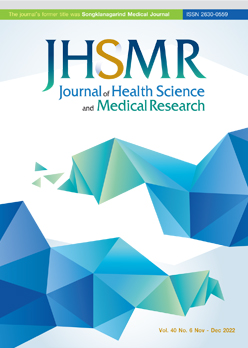Evaluation of Strain and Shear Wave Ultrasound Elastography in Predicting Malignancy in BI-RADS Categories 4A and 4B Breast Lesions
DOI:
https://doi.org/10.31584/jhsmr.2022874Keywords:
benign breast lesion elasticity, BI-RADS 4A and 4B breast lesions, breast lesion elasticity, breast ultrasound elastography, malignant breast lesion elasticityAbstract
Objective: To evaluate elasticity (E) and optimal cut-off values in differentiating benign and malignant tumors in patients with breast imaging–reporting and data system (BI-RADS) 4A/4B lesions.
Material and Methods: Patients aged above 18 years with BI-RADS 4A/4B lesions who had tissue biopsies November 2019 - January 2021 were enrolled. B-mode ultrasound BI-RADS classification, E/B distance ratio, and mean elasticity value in kPa and shear wave velocity (SWV) in m/s were recorded pre-biopsy.
Results: A total of 148 lesions in 141 patients were included, 129 benign (87.2%), 3 high-risk (2.0%), and 16 malignant (10.8 %). Patients with breast cancer or high-risk lesions were approximately ten years older than those with benign lesions (58.9±10.5 years vs 48±10.6 years of age) (p-value<0.001). The elasticity values were significantly different between the benign and malignant groups with median E/B distance ratios 0.9 and 1.2 (p-value><0.001), median kPameans 4.2 and 7.2, and SWVmeans 1.2 m/s and 1.6 m/s, respectively. Setting SWVmean >1.28 m/s as a cut-off value showed the highest sensitivity (68.0%) among the three single elasticity values, and kPamean >7 the highest specificity (82.0%). The negative predictive value was very high, 91.0-93.0%, for all methods. When using a combined E/B ratio >1 and SWVmean >1.28 as a cut-off value, specificity increased to 93.0% with a high NPV but lower sensitivity.
Conclusion: Using a combined E/B ratio >1 and SWVmean >1.28 as a cut-off value can help to differentiate between benign and malignant BI-RADS 4A and 4B lesions and avoid unnecessary biopsies.
References
Sung H, Ferlay J, Siegel RL, Laversanne M, Soerjomataram I, Jemal A, et al. Global cancer statistics 2020: GLOBOCAN estimates of incidence and mortality worldwide for 36 cancers in 185 countries. CA Cancer J Clin 2021;71:209-49.
Freer PE. Mammographic breast density: impact on breast cancer risk and implications for screening. RadioGraphics 2015;35:302–15.
Berg WA, Zhang Z, Lehrer D, Jong RA, Pisano ED, Barr RG, et al. Detection of breast cancer with addition of annual screening ultrasound or a single screening MRI to mammo- graphy in women with Elevated Breast Cancer Risk. JAMA 2012;307:1394–404.
Chang JM, Won JK, Lee KB, Park IA, Yi A, Moon WK. Comparison of shear-wave and strain ultrasound elasto graphy in the differentiation of benign and malignant breast lesions. AJR Am J Roentgenol 2013;201:W347–56.
Barr RG, Nakashima K, Amy D, Cosgrove D, Farrokh A, Schafer F, et al. WFUMB guidelines and recommendations for clinical use of ultrasound elastography: part 2: breast. Ultrasound Med Biol 2015;41:1148–60.
Zheng X, Huang Y, Wang Y, Liu Y, Li F, Han J, et al. Combination of different types of elastography in downgrading ultrasound breast imaging-reporting and data system category 4a breast lesions. Breast Cancer Res Treat 2019; 174:423–32.
Tamaki K, Tamaki N, Kamada Y, Uehara K, Miyashita M, Ishida T, et al. A non-invasive modality: the US virtual touch tissue quantification (VTTQ) for evaluation of breast cancer. Jpn J Clin Oncol 2013;43:889–95.
Liu H, Zhao LX, Xu G, Yao MH, Zhang AH, Xu HX, et al. Diagnostic value of virtual touch tissue imaging quantifi cation for benign and malignant breast lesions with different sizes. Int J Clin Exp Med 2015;8:13118–26.
Tozaki M, Isobe S, Fukuma E. Preliminary study of ultrasono graphic tissue quantification of the breast using the acoustic radiation force impulse (ARFI) technology. Eur J Radiol 2011;80:e182–7.
Tang L, Xu HX, Bo XW, Liu BJ, Li XL, Wu R, et al. A novel two-dimensional quantitative shear wave elastography for differentiating malignant from benign breast lesions. Int J Clin Exp Med 2015;8:10920–8.
Liu BX, Zheng YL, Shan QY, Lu Y, Lin MX, Tian WS, et al. Elastography by acoustic radiation force impulse technology for differentiation of benign and malignant breast lesions: a meta-analysis. J Med Ultrason 2016;43:47-55.
Au FW-F, Ghai S, Moshonov H, Kahn H, Brennan C, Dua H, et al. Diagnostic performance of quantitative shear wave elastography in the evaluation of solid breast masses: deter- mination of the most discriminatory parameter. AJR Am J Roentgenol 2014;203:W328–36.
Berg WA, Cosgrove DO, Doré CJ, Schäfer FKW, Svensson WE, Hooley RJ, et al. Shear-wave elastography improves the specificity of breast US: the BE1 multinational study of 939 masses. Radiology 2012;262:435–49.
Dória MT, Jales RM, Conz L, Derchain SFM, Sarian LOZ. Diagnostic accuracy of shear wave elastography – Virtual touchTM imaging quantification in the evaluation of breast masses: impact on ultrasonography’s specificity and its ultimate clinical benefit. Eur J Radiol 2019;113:74–80.
Luo T, Zhang JW, Zhu Y, Jia XH, Dong YJ, Zhan WW, et al. Virtual touch imaging quantification shear-wave elastography for breast lesions: the diagnostic value of qualitative and quantitative features. Clin Radiol 2021;76:316.e1-e8.
Biondić Špoljar I, Ivanac G, Radović N, Divjak E, Brkljačić B. Potential role of shear wave elastography features in medullary breast cancer differentiation. Med Hypotheses 2020;144:110021.
Downloads
Published
How to Cite
Issue
Section
License

This work is licensed under a Creative Commons Attribution-NonCommercial-NoDerivatives 4.0 International License.
























